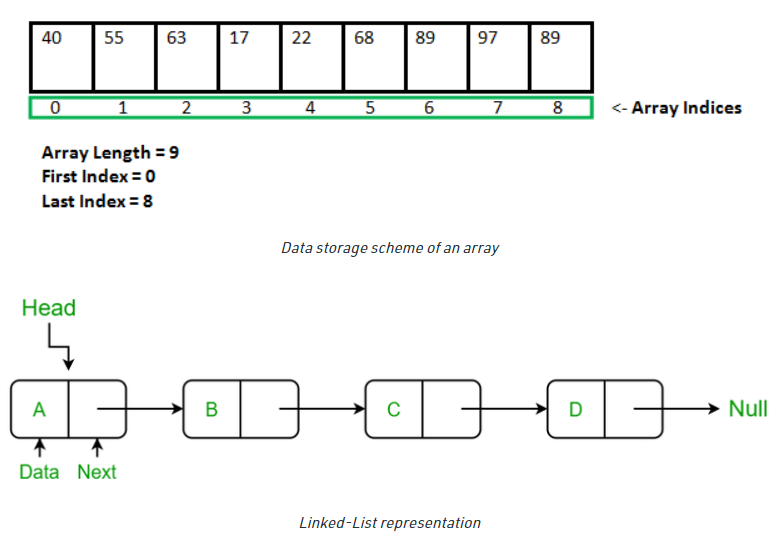Notice
Recent Posts
Recent Comments
Link
| 일 | 월 | 화 | 수 | 목 | 금 | 토 |
|---|---|---|---|---|---|---|
| 1 | 2 | 3 | 4 | 5 | 6 | |
| 7 | 8 | 9 | 10 | 11 | 12 | 13 |
| 14 | 15 | 16 | 17 | 18 | 19 | 20 |
| 21 | 22 | 23 | 24 | 25 | 26 | 27 |
| 28 | 29 | 30 | 31 |
Tags
- Actor-Critic
- clip intensity values
- Excel
- Knowledge Distillation
- scowl
- sidleup
- 자료구조
- REINFORCE
- domain adaptation
- loss functions
- remove outliers
- rest-api
- shadowing
- resample
- non parametic softmax
- noise contrast estimation
- Inorder Traversal
- normalization
- freebooze
- model-free control
- sample rows
- fastapi
- 3d medical image
- checkitout
- thresholding
- MRI
- pulloff
- straightup
- objective functions for machine learning
- Policy Gradient
Archives
- Today
- Total
Let's Run Jinyeah
[Python] Data structures - Stack, Queue 본문
Basic data structures
- array, list, tuple
- linked list
- set, dictionary
- graph, tree
- stack, queue
Stack(=array)
- 선입후출
- 리스트 라이브러리 이용
- append(): 리스트의 가장 뒤쪽에 데이터 삽입
- pop(): 리스트의 가장 뒤쪽에서 데이터 꺼냄
Queue
- 선입선출
- collections 모듈에서 제공하는 deque 자료구조 활용
- 속도가 리스트 자료형에 비해 효율적이며, queue 라이브러리를 이용하는 것보다 더 간단
from collections import deque queue = deque() queue.append((x,y)) x, y = queue.popleft()
Linked List
Why?(=Array limitation)
- The size array is fixed
- Insertion of a new element / Deletion of a existing element in an array is expensive

Drawbacks of Linked List
hard to access specific element, need to access elements sequentially starting from the first element
Representation of the linked list
# Node class
class Node:
# Function to initialize the node object
def __init__(self, data):
self.data = data # Assign data
self.next = None # Initialize next as null
# Linked List class
class LinkedList:
# Function to initialize the Linked List object
def __init__(self):
self.head = NoneInsertion
class LinkedList:
# Function to initialize the Linked List object
def __init__(self):
self.head = None
# Function to insert a new node at the beginning
def push(self, new_data):
# 1 & 2: Allocate the Node &
# Put in the data
new_node = Node(new_data)
# 3. Make next of new Node as head
new_node.next = self.head
# 4. Move the head to point to new Node
self.head = new_node
# Function to insert a new node after the given prev_node
def insertAfter(self, prev_node, new_data):
# 1. check if the given prev_node exists
if prev_node is None:
print("The given previous node must inLinkedList.")
return
# 2. Create new node & 3. Put in the data
new_node = Node(new_data)
# 4. Make next of new Node as next of prev_node
new_node.next = prev_node.next
# 5. make next of prev_node as new_node
prev_node.next = new_node
# Appends a new node at the end.
def append(self, new_data):
# 1. Create a new node
# 2. Put in the data
# 3. Set next as None
new_node = Node(new_data)
# 4. If the Linked List is empty, then make new node as head
if self.head is None:
self.head = new_node
return
# 5. Else traverse till the last node
last = self.head
while (last.next):
last = last.next
# 6. Change the next of last node
last.next = new_node참고
[책] 이것이 취업을 위한 코딩테스트이다
https://www.geeksforgeeks.org/insertion-in-linked-list/
'Programming > Algorithm' 카테고리의 다른 글
| [Python] Data Structure - Tree (0) | 2021.10.19 |
|---|---|
| [Python] 이진탐색 (0) | 2021.10.19 |
| [Python] 정렬 - 선택, 삽입, 퀵 (0) | 2021.10.14 |
| [Python] 기본 탐색 - 완전탐색, DFS/BFS (0) | 2021.10.14 |
| [Python] Graph 종류 및 구현 (0) | 2021.10.14 |
Comments

